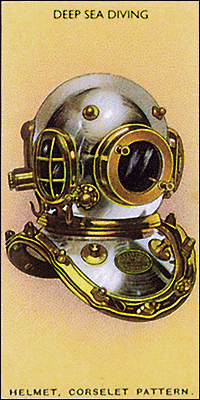
The Twelve Bolt Helmet was manufactured continuously by Siebe Gorman from 1837 to 1975. It took its name from the number of bolts which project from the shoulder or ‘corselet’ piece.
The rubber and canvas diving suit would be tightly clamped in place on these bolts, making a watertight seal. The top of the helmet could then be screwed in place and the diver descend.
Used all over the world, the Twelve Bolt was copied by many other manufacturers, versions of it are still produced in some countries today. Its simplicity and robust reliability meant that divers could be quickly and easily trained in its use, and for many years it was the workhorse of the diving world. The twelve bolt helmet is the archetypal piece of Deep Sea Diving equipment.
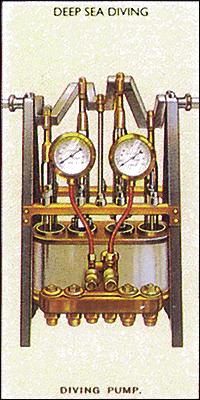
The success of Augustus Siebe (1788-1872) in developing early diving apparatus was a result, of his ability to construct diving helmets, and his established expertise in the manufacture of pumps; the production of the first practical diving apparatus, in the 1820s, was a result of improvements in air pumping and helmet technology.
Siebe’s force pumps were of the highest quality, and gradually there arose a demand for more powerful and efficient machines. A wide variety of hand-powered pumps were produced, from ‘portable’ single cylinder lightweights designed for expeditionary work, to three or even four cylinder pumps for tasks requiring hard work and an even air supply.
A twin cylinder design, first produced for the Royal Navy, possessed a dual capability allowing two divers to work at moderate depths or a single diver much deeper.

Augustus Siebe first offered his improved 12 bolt diving apparatus to the Admiralty in 1837. It quickly became the official ‘Standard Pattern’ service diving equipment and was popularly known as Standard Dress. However the first forces divers were not from the Navy but the Royal Sappers and Miners (Royal Engineers), who established a diving school in the 1840s. They proved beyond doubt the efficiency and robust qualities of Augustus Siebe’s design. It was easy to use and maintain and provided the diver possessed qualities of self-reliance and cool thinking quite astounding underwater tasks could be carried out. Standard Dress revolutionised diving, making the underwater worker an essential part of both salvage and civil engineering. Without divers many of the great building projects of the Victorian era. bridges, lighthouses and tunnels which we still use today, could not have been built.
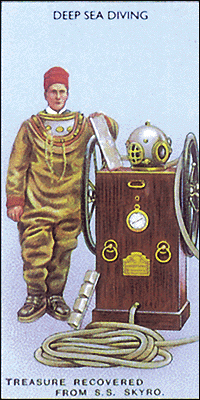
The S.S. Skyro sank in deep water after striking a reef off Cape Finisterre in 1891 carrying a valuable cargo of silver bullion.
Two salvage attempts failed due to the extreme depth and persistent bad weather, until in 1896, the Spanish diver, Erostarbe, using Siebe Gorman equipment, finally located the treasure at a depth of 20 fathoms. Erostarbe used dynamite to gain access to the cabin where the silver was stored. This was not easy, after five years on the sea bed the Skyro had broken up and the deck above the strong-room had collapsed to within 18” of the cabin floor. On the surface boisterous weather and strong currents made tending the diver difficult.
Nevertheless Erostarbe clawed a path to the bullion and during several long, deep, dives recovered 59 bars of silver.

Tanks were constructed for training both at the Siebe Gorman works in London and the Royal Navy base at Portsmouth, where new recruits were instructed in the diver’s ‘art’.
The very first instructions to divers included the following list of ailments which precluded a man from going underwater:
1. Men with short necks, full blooded, and florid complexions.
2. Men who are very pale, whose lips are more blue than red, who are subject to cold hands and feet, men who have what is commonly called a languid circulation.
3. Men who are hard drinkers, and have suffered repeatedly and severely from venereal disease, or who have rheumatism, or sunstroke.
On the other hand diving was seen as “an excellent remedy” for, “asthma, emphysema, or swelling of the integuments”.
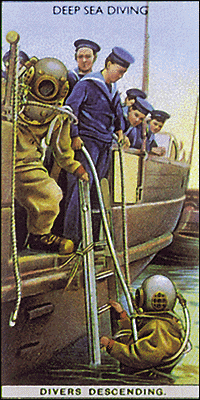
The diver became an important member of any royal Navy crew, and a special training school was set up in HMS Excellent at Portsmouth.
All but the smallest vessels carried divers and equipment. Wherever in the world a naval force operated a diving team could be called upon.
The ‘Ships Divers’ carried out routine underwater maintenance such as unblocking inlets, freeing tangled propellers, and effecting minor repairs, tasks which previously required expensive and time-consuming dry docking. Equipment lost overboard could be recovered, provided the water was not too deep.
For difficult and deep water tasks the navy maintained a specialist unit. Consulting closely with Siebe Gorman, the navy continually updated and upgraded its equipment, providing the driving force behind many technical developments.
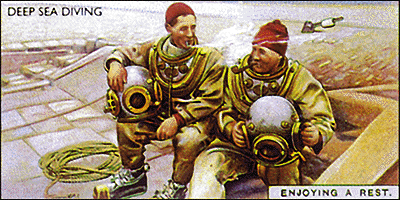
Despite the vast improvements in diving that Siebe’s apparatus brought about, divers, particularly those who dived deep, retained a special status. Often working single-handed, and always on their own initiative, the ‘Deep Sea Diver’ became an individual who commanded the greatest awe and respect. In the early days diving physiology was poorly understood; only men of a certain physical type could dive effectively to depths in excess of 33 feet. There was no way of predicting who these individuals might be and, given that diving also required physical strength, steady nerves, and considerable engineering skills, genuine ‘deep sea divers’ were men apart.
This elite of the diving world was always in great demand, salving lost valuables and carrying out civil engineering tasks in difficult conditions. It was a dangerous, glamorous live, and a very well paid one!
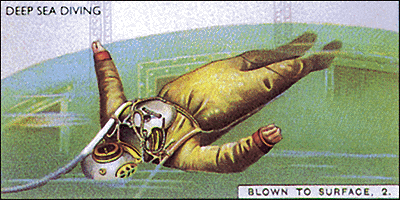
Standard diving equipment, despite appearances, is in fact incredibly buoyant. Although the diving helmet is extremely heavy at the surface, once on the sea bed the diver is only kept there by weights attached to his back, chest and boots.
Inexperienced divers, or divers working in different positions, occasionally suffered a phenomena known as ‘blowing up’. The diver inadvertently allowed more air to enter the suit than was exiting via the helmet valve. Within a very short space of time the diver would become positively buoyant and shoot, out of control, to the surface.
So dangerous was ‘blowing up’ that divers under instruction were required to deliberately experience it before their training was considered complete. Should a diver ‘blow up’, there was the danger that he would rise too quickly, collide with the diving vessel, or become helplessly entangled.
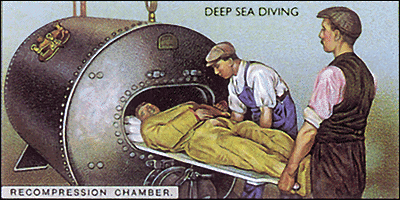
One of the greatest dangers that divers face is that of decompression sickness or ‘the bends’. Nitrogen, held in solution in the body’s tissues, is suddenly liberated as bubbles of gas when the diver ascends. The effects range from a slight rash to death.
During the early days this physiological phenomenon was little understood and, although a number of theories for avoidance were advanced, deep diving – anything below 40 feet – was always a risk.
In 1905 Professor J S Haldane, working for the British Admiralty, devised a method of ‘Stage Decompression’ whereby divers were brought to the surface in a series of ‘stops’, allowing nitrogen to dissipate harmlessly.
Decompression accidents still occasionally occurred, and special chambers were manufactured, many by Siebe Forman, in which a diver could be rapidly repressurised for a very slow and controlled ‘ascent’.
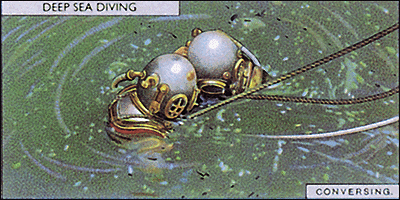
Although water is a very good conductor of sound, Standard Divers working alongside one another were unable to converse normally. The underwater world is anything but silent, and conversation was impossible.
However, one improvised method was devised. Experienced divers would touch helmets and speak, the sound being transmitted via the copper domes.
Unfortunately ‘reception’ was rather poor and the bulky Standard Diving equipment was unsuited to such intricate manouvres.
In any case most diving was carried out in such poor visibility that the divers would have had difficulty in finding one another!
As a result, few divers felt the inclination or need to speak. Diving, at least in the early days, was regarded as a solitary task, and if divers had to work in pairs it was generally without the need for verbal communication.
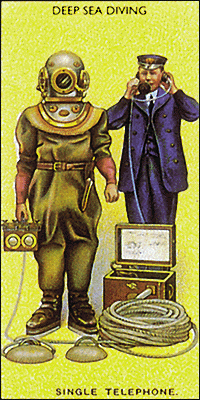
Towards the end of the 19th century a number of surface/diver communication systems were devised. The first of these consisted simply of a long tube attached to the diver’s helmet through which the surface attendant and diver shouted to each other. This proved less than adequate and in the 1880s electrically powered telephone systems were devised.
At first these ‘new-fangled’ systems were resented by he divers,. replacing as they did a time honoured system of rope signals. Divers saw the intrusion of a voice from the surface as an unnecessary interference in their right to work as they wished, and failed to see how the ability to say a few words could possibly make any difference to the tasks they carried out.
As time went by, surface/diver communications became established, and eventually a requirement, adding greatly to diver safety.
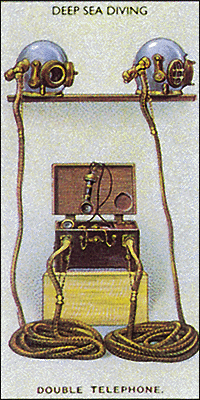
As diving tasks became more complex, divers needed to communicate remotely, for example, at either end of a sunken vessel.
To begin with this was carried out by two single telephones manipulated by an attendant. This individual would speak to both divers in turn, passing the instructions and comments of one on to the other and vice versa (telephone operators were renowned for their diplomatic skills!).
Siebe Gorman then introduced a double telephone system, whereby two divers could speak to each other and the attendant at the same time. Great discipline was required to keep verbal order, and the telephone operator still retained a ‘veto’ over who spoke to whom, and how.
In general, telephone communications were not popular with experienced divers. They saw comments from the surface, and even other divers, as unnecessary and complicated.
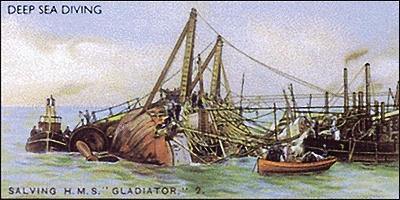
The 5750 tone cruiser HMS Gladiator sank in the Solent in 1908 following a collision, a huge hole in her side sending her to the bottom very quickly indeed.
The Liverpool and Glasgow Salvage Association, in conjunction with the Admiralty, undertook a momentous operation to bring her ashore.
Although lying in shallow water, damage to the cruiser was so extensive that huge wooden patches had to be fixed before she could be pumped out. So swiftly had she sank, most of the watertight doors – normally closed in an emergency – were still open, and divers had to penetrate the wreck in order to close them.
It was harrowing work. The sorpses of sailors who had struggled to close the doors as the vessel went down were still inside and the divers, working in pitch darkneww and extremely confined spaces had literally to shoulder them aside.

The salvage of sunken ships was nothing new. Long before Siebe’s diving apparatus men had found sometimes quite effective ways to raise lost vessels and cargos.
However, the advent of a practicable diving apparatus provided the salver with his most valuable tool – human hands – and salvage enetered a new era. The first divers began their careers by concentrating on a vast backlog of sunken vessels left by centuries of maritime disaster, which previous salvers had been forced to abandon.
Lucrative contracts were signed for the dispersal of wrecks in awkward places, whilst those vessels known, or thought, to contain treasure were quickly located and dived.
However, as time went by, the diver’s role became more one of supporting traditional techniques, enabling salvers to carry out patching, pumping, and lifting more quickly and effectively than ever before.
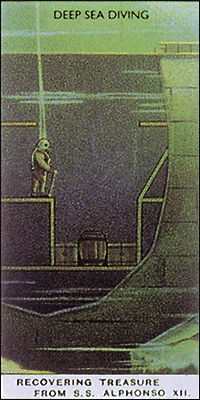
In 1885 siebe Gorman’s chief diver, Alexander Lambert, was sent by the company to the Canary Islands, and the wreck of the Alphonso Xii.
Sunk on route to Cuba, the Alphonso carried £100.000 in gold coin, which the underwriters were extremely anxious to recover. Unfortunately the wreck lay in over 180 feet of water, deeper than any salvage diver had ever been.
In a series of stupendous dives Lambert used explosives to blast through several decks until, at a depth never before achieved, he found the treasure.
Lambert and a fellow diver recovered nine out of ten boxes of coin although, during his last dive Lambert, in a supreme effort, recovered two boxes and stayed too long at that great depth, succumbing to the dreaded ‘bends’.

Perhaps the least glamorous of diving tasks belong to the dockyard diver. dockyards are notoriously grimy places and nowhere more so than underwater. Ships constantly docking and undocking required the services of divers, whilst the structure of the yard itself, warranted a permanent team of underwater masons and carpenters.
The Royal Naval dockyard at Portsmouth employed several teams of Standard Divers. Each group had its own special skills in construction, maintenance, and engineering. They not only tended to the docking of ships but if possible repaired them as well.
Dry docking a ship is expensive and time consuming, and any task carried out underwater is both cheaper and faster.
Highly skilled Standard Divers could change propellers and repair minor damage, keeping naval vessels afloat and ready for action.
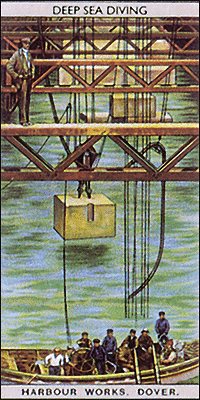
Most underwater work using Standard Dress was concerned not with the mundane tasks of Civil Engineering.
The appearances of Siebe’s diving apparatus coincided with a period of immense and innovative building. New ideas, techniques and materials enabled engineers to construct railways, roads, bridges, tunnels, lighthouses and docks as never before. It is difficult to see how many of these could have been completed successfully without the work of divers, whilst maintenance and upkeep would have been virtually impossible.
Divers were particularly useful in the construction of harbours, and were often employed in conjunction with a diving bell.
Manufactured by Siebe Gorman, these huge metal structures could accommodate a whole gang of men, who carried out heavy labour on the sea bed without special equipment.

From the very earliest days of diving methods were sought to cut metal effectively underwater. When most ships and harbours were constructed of wood, this was a minor difficulty, but as the nineteenth century progressed and iron and steel became commonplace it presented a major problem.
The only real reasonable solution in early times was to use explosives, in themselves often crude and unpredictable. Too small a charge left the offending structure intact – perhaps even more difficult to remove. Too much could initiate unintentional and widespread damage!
During the First World War attempts were made to use explosives in a controlled manner, but with limited success.
However, towards the end of the war, Siebe Gorman produced the world’s first practicable underwater electric arc cutting system. It was crude, but given that electricity and water are always uncomfortable bedfellows, moderately effective.
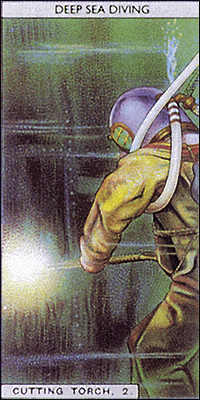
The answer to underwater cutting lay in the development of a gas flame system.
The end of WWI provided the impetus for this with large numbers of wrecks waiting to be salvaged and dozens of harbours requiring reconstruction. Siebe Gorman, in collaboration with the British Oxygen Company, developed Oxy-hydrogen torches for underwater use.
During WW2 the underwater cutting torch came into its own, proving a vital factor in the progress of various military operations.
Standard Divers using underwater cutting equipment enabled naval salvage parties to quickly and effectively remove obstacles and blockships from recently captured harbours, allowing supplies to be unloaded for the front. During the Normandy operations underwater cutting proved especially valuable in connection with the repair of damaged landing craft. Divers simply cut away damaged areas and welded in new plates.

Whilst Siebe Gorman Standard Diving equipment was principally designed for use with surface supplied air, attempts were made before the Second World War to use the apparatus in a self-contained role.
This involved replacing the heavy lead weights with a compressed oxygen breathing apparatus. To give greater endurance, the oxygen breathed out was passed through a chemical filter, removing waste carbon dioxide, and enabling the remaining oxygen to be ‘re-breathed’.
Unfortunately, pure oxygen becomes poisonous at quite moderate depths, and the diver, deprived of his plentiful air supply, could only do limited work. Although Siebe Gorman had made a great effort, the self-contained Standard Diver was not a success.
Meanwhile in the Mediterranean, free swimming pioneers such as George Commeinhes and Yves Le Prieur, were perfecting compressed air Scuba, whilst Hans Hass was the first to swim underwater with ‘flippers’ or fins.
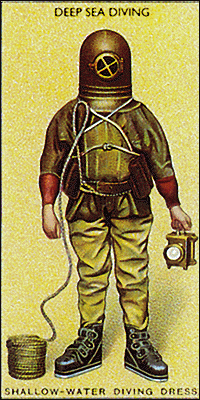
The very first diving dress manufactured by Augustus Siebe in the 1820s for the diving pioneer charles Deane consisted of a helmet attached to a short leather jacket. This ‘Open Dress’, was quickly superseded by the 12-bolt helmet and suit introduced in 1837.
However, the concept of a combined helmet and waterproof jacket continued to be used for many years in a so-called shallow water apparatus. Supplied by a small cylinder of oxygen the diver was, in comparison to his Standard Dress cousin, relatively lightweight and manoeuverable. The equipment could also be stored in a relatively small space, making it popular aboard vessels where there was not enough room to maintain and operate conventional equipment.
Shallow water equipment was particularly useful in confined spaces – entering a flooded compartment for example – whilst it also doubled as an apparatus for penetrating smoke-filled rooms.

During the early years of the 20th century various attempts were made to develop a very lightweight diving apparatus which obviated the need for any kind of bulky helmet or suit.
Drawing on previous designs for mine rescue apparatus, Siebe Gorman produced a waterproof jacket with a flexible hood. Supplied with oxygen from an integral cylinder, the apparatus also had a small chemical filter strapped to the back.
Nevertheless, the buoyancy of the jacket and hood proved such that it was necessary to add weight in the form of lead blocks hung from the belt, whilst to prevent the diver flipping upside down, even more lead blocks were strapped to the ankles.
Thus the apparatus was anything but lightweight and not very practical, but these early attempts at producing self-contained equipment paved the way for future, more successful, devices.
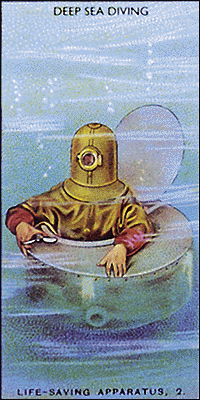
Early experimental submarines had a tendency to sink, and a number of accidents before the First World War made the Admiralty look into the possibility of developing an escape apparatus for use by trapped crews. One of these, designed by Captain S.S. Hall and Fleet Surgeon O. Rees, and manufactured by Siebe Gorman, briefly went into production.
It incorporated a canister containing ‘Oxylithe’, a special chemical which when breathed upon gave off oxygen and absorbed carbon dioxide. This eliminated the need to carry compressed oxygen, thus saving weight and increasing safety. The original apparatus had a flexible hood, but this was later abandoned in favour of a metal helmet which protected the head of the wearer.
Despite its workable design, the Hall-Rees apparatus was phased out – one for each crew member simply took up too much room in a cramped submarine.
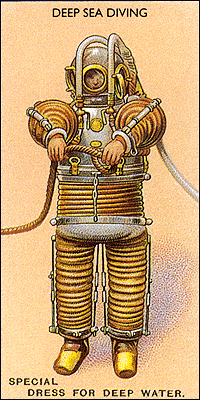
It was soon recognized that the answer to very deep diving was to enclose the diver in a chamber strong enough to resist the immense pressure of the sea, allowing the occupant to breath under ordinary atmospheric conditions. All problems of decompression and breathing at depth would thus be eliminated.
Unfortunately a diver enclosed in a steel chamber can do no work, and at the end of the 19th century numerous attempts were made to combine the flexibility of the ordinary diving dress with the strength of a metal skin. Few of the early designs had merit, most ignoring the obvious, dangerous effect of allowing the diver’s unprotected hands to emerge from the suit. By the 1920s the designs had become quite intricate, although they still had leaking joints which were difficult to move when the water pressure increased. It was not until the 1930s that Peres designed the ‘Tritonia’ – the first fully working atmospheric jointed suit.

HMS Gladiator, a cruiser of 5750 tons and some 320 feet long, sank after a collision in 1908. The job of salvaging her was given to the Liverpool Salvage Association. She was lying with her port side visible at high tide. Her 15 ton guns were first removed with other heavy equipment by divers. All openings were made watertight. A decision was made to haul her into shallow water, floating her with the aid of pontoons. She would then be hauled upright and towed away.
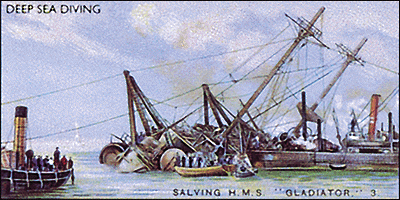
HMS Gladiator, a cruiser of 5750 tons and 320 feet long, sunk after a collision in 1908. After floating her with pontoons the Liverpool Salvage Association decided to haul her upright before towing her into shallow water.
In this picture she is being hauled upright by two anchored salvage vessels and their capstans, 280 tons of pig iron was strapped to one side of the ship to assist in righting her. Trestles can be seen in the distance on the salvage vessels.
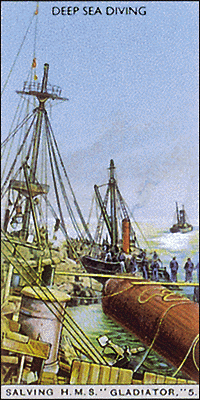
HMS Gladiator a cruiser of 5750 tons, and 320 feet long, sank after a collision in 1908. The Liverpool Salvage association decided to haul her into shallow water using the aid of pontoons which were sunk alongside the wreck then attached to it. They were then filled with air and the wreck floated.
Seven pontoons were used, 1 x 75 ft long and 12 ft in diameter, 2 x 40 ft by 12 ft, 2 x 50 ft by 10 ft and 2 x 50ft by 12 ft. Like enormous barrels they were made from steel and, when filled with air, lifted the ship off the bottom.
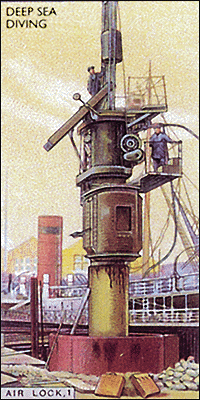
Air locks were extremely important for all aspect of diving work where pressure had to be maintained in enclosed areas such as diving bells and decompression chambers. Materials and men could pass through these locks and the pressure be maintained below.
Although not divers, the workmen who worked in diving bells were subject to the same rules regarding the absorption of nitrogen by the body. Tables were laid down governing how long they stayed down and how long they would take to come to the surface. Without these rules they would suffer The Bends, the diver’s terror.
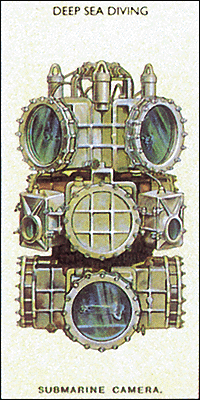
At the end of World War I in 1918 the Allied command was faced with he task of clearing, not only minefields, but booby traps from coal and other mineral mines in France and Belgium. These mines had been flooded by the Germans during their retreat.
When the allies tried to clear these mines there were a number of serious accidents. The French government commissioned Siebe Gorman and Co. Ltd to make the camera shown overleaf. This consisted of a housing 4'9" high by 3'4" in diameter. It contained powerful lights and cameras facing different ways. It was lowered into the mines to detect the booby traps.
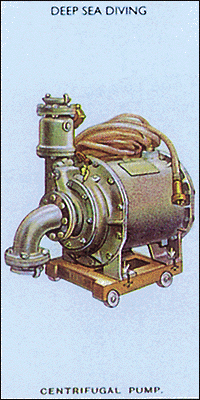
Salvage operations depended greatly on the salvors’ ability to move enormous quantities of water in and out of wrecks and pontoons. To do this quickly and efficiently Siebe Gorman & Co. Ltd designed a Centrifugal Pump which would operate under water.
The pumps were designed in various sizes. The 12” pump at a depth of 33 feet would pump 180 tons of water per hour. A number of pumps could be used in relay, or separately as required. The water could be pumped into holding tanks or from one part of the wreck to another.

The weight of the diving helmet, weights, boots and rig is about 180 lbs in total. This is obviously very heavy on the surface, although in the water the buoyancy of the suit and helmet neutralises this weight. The diver can make himself lighter or heavier, depending on what work he has to do, by operating the air exhaust valve on the back of the helmet. He has control over his own buoyancy and can even inflate the suit to bring him to the surface. The Copper helmet and rig is still used today and is preferred by divers for certain types of heavy work.
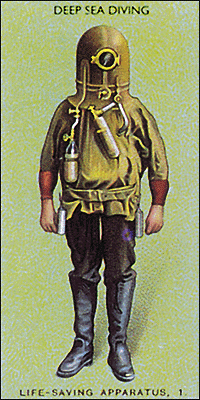
Over the years many submarines were sunk for a variety of reasons. The difficulty in rescuing crew from these wrecks was extreme, bearing in mind the early diving equipment available. Methods of submarine escape began to develop, including miniature diving bells which could be either attached to the outside of the submarine or lowered down to it.
These devices could also be used for other submarine rescues. The device shown on this card could hold several people who sat in the water with their heads in the air space inside the upper part of the bell.
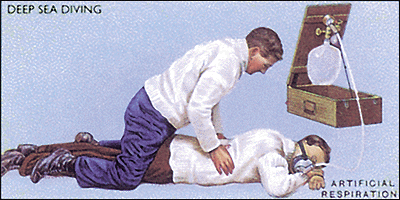
Drowning, for professional divers is a hazard they live with daily. Death can occur in seconds, so it became essential to develop an apparatus for resuscitating those who became victims of the sea. The respirator shown overleaf is an early oxygen supply system to be used in conjunction with resuscitation procedures.
As you can see from the picture, procedures have changed somewhat over the years. this method has given way to Expired Air Resuscitation (Mouth to Mouth). Oxygen sets are now a compulsory part of every dive boat’s equipment, as oxygen is also used to treat cases of the bends or Caissons disease.
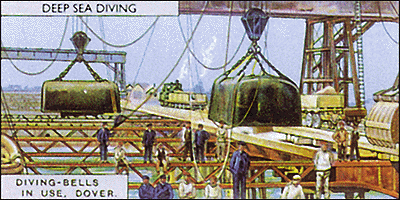
During the construction of Dover harbour, large square shaped Diving Bells were used to enable construction workers to work on the sea bed, clearing obstructions, laying pipework or concrete.
This type of bell had no air lock to pass materials or men through. The bell was raised and lowered with the workmen sitting on benches around the edge. The bottom of the bell was open to the water and the water was kept out by air pressure pumped from the surface. The workmen were subject to the same decompression rules as divers and could suffer ‘the Bends’ if brought up too quickly. They operate with the same Decompression Tables as Divers use.

The picture overleaf shows a purpose-built barge equipped with an air lock diving bell system. The bell was lowered over the site down through the centre of the barge and was connected to it by a steel shaft down which the men entered.
The barge was also equipped with rescue equipment including a decompression chamber. The barge would have been hove to with six or eight anchors to keep it in place; good weather was obviously required. With this mobile system work could continue for 24 hrs with changes of workmen.
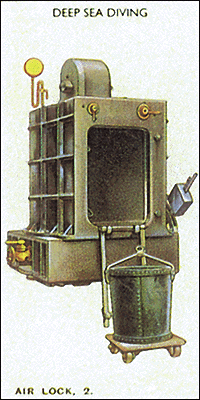
Air locks became a vital piece of equipment for workers and divers carrying out work at depth. The lock served several purposes; to keep the water out of a diving bell and the air in when a shift change took place.
Also, if the workmen or divers had to decompress, they could be brought to the surface in the air lock with the pressure maintained and decompressed on the surface.
Being able to exchange material and tools and for engineers to inspect work being carried out was also a great advantage.
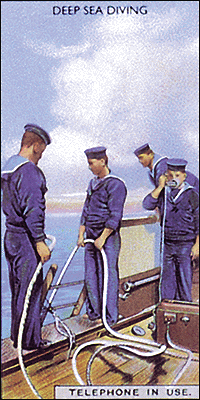
The diver’s telephone is a 20th century invention which entered service in about 1912. Prior to this date the diver used either a communication tube connected to the helmet that he had to shout along, or a series of complicated signals sent via his air line or safety line.
These signals had to be learned by the diver and his tender on the surface. The tender had to be sensitive to his diver’s movements and signals. Many a tender has saved his diver’s life through sensing something had gone wrong.

The dress, or suit of a helmet diver is made from a tan twill canvas which has a layer of rubber sandwiched between the inner and outer layers. It is totally watertight and is sealed with rubber seals at the divers wrists and on the corselet of the helmet.
In this picture the legs have laces down the back. This is to prevent the legs becoming inflated in the event that the diver turns upside-down. This could prove dangerous for the diver who would not be able to right himself without help.
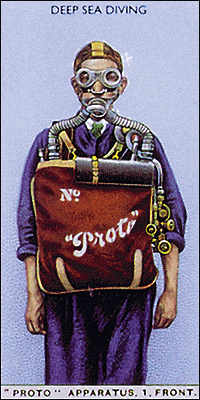
The PROTO self-contained breathing apparatus was for use under water or in irrespirable atmospheres. It consisted of goggles with nose clip, a mouthpiece with two tubes leading to a breathing bag and oxygen scubber. An oxygen cylinder supplied fresh oxygen when required. This apparatus was for shallow water work only. Oxygen becomes poisonous to the human body and can cause convulsions if dived to deep.
The apparatus proved invaluable in smoke or gas-filled environments
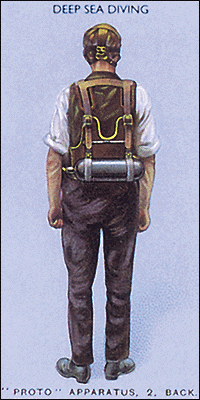
The PROTO self-contained breathing apparatus was designed to be used underwater and in irrespirable atmospheres. This picture shows the oxygen cylinder attached to the back of the harness.
This apparatus proved itself in 1946 in the salvage of the MV Rippingham Grange involved in a collision outside Port Said. She had 6000 tons of meat in her holds which had become a putrefied mess giving off a poisonous gas. Five men died before it was realised. The holds were eventually cleared using the PROTO apparatus.
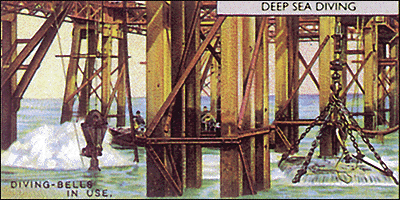
The diving bell has been used extensively for reaching the sea bed for 300 years and is still used today, particularly in the construction industry when working on harbours or ports. They were used extensively in Dover harbour during its construction.
The men in these bells often suffered the ‘bends’ as they were subject to the same rules of decompression as divers. Tables were formulated by Professor Haldane in 1920s to overcome this problem. The body absorbs nitrogen under pressure and this has to be released slowly during ascent to avoid it bubbling in the blood.

The sea around the British coast and in most European waters is not as clear as most people think; in fact it can be very murky indeed. At depth the light can go completely. To enable divers to work in these conditions Siebe Gorman @ Co Ltd. designed and build a powerful submarine lamp of 2000 candle power.
Sometimes even the lamp would not help if the water was very silty or full of plankton. The divers would then work by feel alone. The mine clearance divers of World War II usually worked completely blind in dirty harbours diffusing mines and booby traps
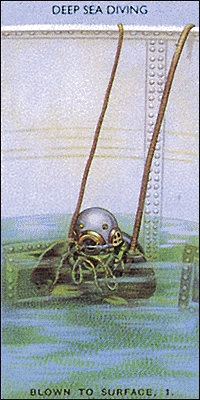
Blowing up was one of the main dangers divers were taught to avoid. As the diver ascended he had to do so slowly, operating the exhaust valve on the helmet to vent air from the suit. If he did not, or he was fed too much air, the suit would inflate and he would shoot to the surface, suffering one of diving’s traumas, the bends or a burst lung, or both.
As the ambient pressure in the water decreases with ascent, so the air in the suit expands. Boyles law – volume determined by pressure, states that “…the pressure is universally proportional to the volume…”
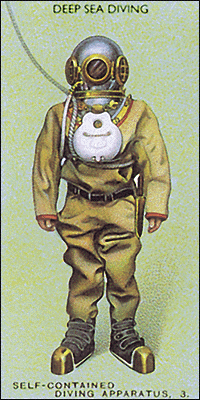

Escape from submarines was always a difficult problem for the royal Navy. In the early days of submarine design many sank, taking the sailors to a watery grave.
Sir Robert Davis of Siebe Gorman @ Co. Ltd. invented the Davis Submarine Escape Equipment (DSEA), but this later design was invented by Captain S. Hall and Fleet Surgeon O. Rees. It was in fact much safer than the DSEA. The suit was fitted with a small oxygen and buoyancy cylinders.
Earlier models had a CO2 scrubbing agent included. However, the suit proved too bulky for submarine use and was used as a shallow water diving dress.

HMS Gladiator a cruiser of 5750 tons and 320 feet long sank after a collision in 1908. the wreck was successfully raised by Captain (later Sir) Frederick Young and his two assistants, Captains Williams and Wilson, all from the Liverpool Salvage Association.
The wreck was floated with pontoons and raised upright but her deck was still awash. To help keep her afloat huge cofferdams were constructed on her decks to act as flotation tanks. Pumps were placed and worked continuously to keep her afloat. She was hauled into shallow water and salvaged.
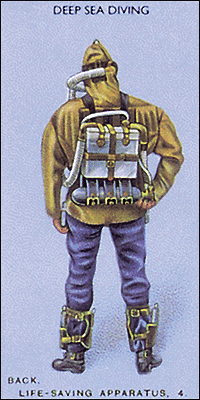
During World War II there was a constant drive at Siebe Gorman & Co. Ltd. to develop an efficient and safe self-contained breathing apparatus. This set was designed not for swimming but for working underwater.The lead weights are placed to keep the diver firmly in place whilst working. The lead around the ankles would prevent him becoming inverted. Although it seems to be a lot of lead the rig was quite buoyant. The aparatus could also be used in irrespirable atmospheres such as gas-filled mines.

Augustus Siebe made the 12 Bolt Helmet in 1837 and production of it continued until 1975. However, the Ministry of Defence required a Helmet made to their own specifications which required a slightly heavier built quality. This was the six bolt helmet, as seen in this picture, the rest of the rig is standard equipment, except for the front weight which has a light fitted to it, to aid the diver. The chest weights weigh about 40lbs. each and are tied down to stop the helmet rising from the diver’s shoulders. The weights are hung from weight hangers on the front of the corselet.

One of the earliest methods of enabling man to work under water was by using a Diving Bell. They were used as far back as the 17th century.
This is a picture of a relatively modern version used during the early 20th century. The Bell at the top of the picture is for deep water and the one at the bottom, for shallow water. In the deep water bell men would sit inside round the edges on benches. They would then be lowered into the water. The water was kept out by the pressure of air pumped down to them inside the bell which was maintained via a surface supply. The Shallow water bell was entered via an air lock which protruded from the water.
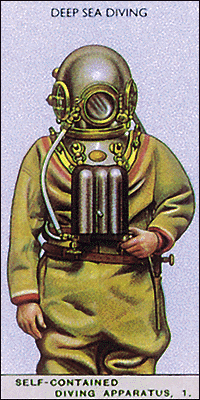
Siebe Gorman @ Co. Ltd. developed this apparatus prior to World War II and at that time it was not a commercial success.
During the War, however, there became an ever-increasing need for this type of equipment. The air inside was recirculated and the CO2 extracted by a scrubbing agent. An oxygen cylinder replenished the oxygen used by the diver.
These rigs could only be used at shallow depths due to the dangers of oxygen poisoning which could lead to convulsions and death.